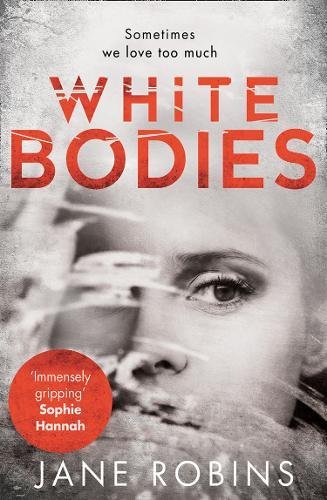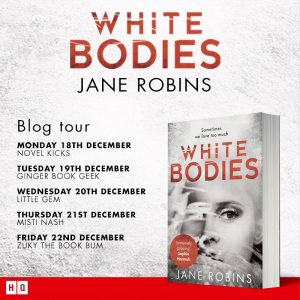From Non-Fiction to Thrillers, Review and Extract: White Bodies by Jane Robins
 White Bodies is the new novel from author, Jane Robins and is due to be released by HQ on 28th December 2017.
White Bodies is the new novel from author, Jane Robins and is due to be released by HQ on 28th December 2017.
‘He’s so handsome and clever and romantic. I just wished he hadn’t forced Tilda under the water and held her there so long.’
Callie loves Tilda. She’s her sister, after all. And she’s beautiful and successful.
Tilda loves Felix. He’s her husband. Successful and charismatic, he is also controlling, suspicious and, possibly, dangerous. Still, Tilda loves Felix.
And Callie loves Tilda. Very, very much.
So she’s determined to save her. But the cost could destroy them all…
Sometimes we love too much.
I’ve reviewed the book below and we also have an extract but first, Jane joins me to chat about going from narrative non-fiction to psychological suspense. Thank you for joining me, Jane. Over to you.
When I was young (just out of university young) I thought ‘one day I’ll write a book’ and I think I had in mind a novel, though I’m not sure what type of novel. Then I shelved the idea for twenty years because, like most of us, I had to make a living. I became a journalist and worked for some great organisations including The Economist, the BBC, and The Independent. It was only when I found myself, in my early 40s, with a small child and wanting to work from home, that I allowed that dream of writing a book to resurface. At that stage I didn’t feel able to write fiction because I couldn’t afford two years or so, with no income, writing something that might sell for a very low sum, or not at all. It was simply too risky. With non-fiction you sell your book to a publisher on the basis of a proposal, and get a chunk of money up front.
Writers rarely talk about the financial side of their careers – the filthy lucre. But the truth is that most of us are not prepared to starve in a garret for our art. It’s not that we lack commitment, I think. It’s rather that we’re not convinced that we have a talent so almighty that it’s worth sacrificing everything else. Not just our income, but duties to our friends and families and duty to be a reasonably productive member of society.
So, when I was offered a contract to write historical non-fiction, I was thrilled. Money up front! Working from home! Over the following years I unlearned my punchy journalistic writing style and tried to write in a more relaxed and lyrical way, hoping that the reader would be happy to stay in my company over hundreds of pages. I found it a very different craft from that required to hold someone’s attention for a mere 600 or 800 words – the length of a newspaper article.
From the beginning, I thought a lot about structure and how to present my historical facts in such a way that the story had a strong narrative pull. I wanted to introduce as much suspense and tension as possible without distorting the underlying, factual story. All three of my non-fiction books have a natural narrative arc – ending in dramatic trials. The first is about the crazy life of Queen Caroline who was put on trial for adultery by her husband, King George IV (the silly Prince Regent in Blackadder.) The other two are about serial killers – George Smith, The Brides in the Bath murderer, who faced trial in 1915, and Dr John Bodkin Adams, an Eastbourne family doctor accused of killing hundreds of his patients. He was tried at the Old Bailey in 1957.
It took ten years to write these three books, and by the end I felt sufficiently confident of my storytelling skills to attempt a novel. At last! Money was still a problem, but with my son now a teenager at secondary school I was able to take a part-time job teaching at the London School of Economics. With that income in the bank, I could spend my spare time writing White Bodies.
My non-fiction writing taught me to appreciate structure, and my plotting scheme for White Bodies took many months and involved many revisions. But I also felt a sense of release. As a writer of non-fiction I had total respect for the facts of my story. I never wrote ‘he must have thought…’ or ‘maybe it occurred to her…’ I was strict. When I started to write fiction, I was like an animal set free into the wild. I could do anything! Go anywhere! Maybe that’s why there is quite a lot of weird behaviour in White Bodies. I feel wonderfully liberated, and I’m sticking with fiction.
My verdict on White Bodies…
 Callie loves her sister, Tilda. Her love on fact borders on obsession. When Tilda meets Felix, Callie’s paranoia and her obsessive nature reaches boiling point.
Callie loves her sister, Tilda. Her love on fact borders on obsession. When Tilda meets Felix, Callie’s paranoia and her obsessive nature reaches boiling point.
Callie finds that she will go to extraordinary lengths to protect Tilda with devastating consequences.
Throughout the novel, I found Callie quite a non descriptive, normal character. She works in a book shop, she’s single and compared to her glamorous actress sister, Callie is almost invisible. It’s a feeling she seems to have experienced all her life. She is used to being in her sister’s shadow and her love is definitely of an obsessive nature.
She is an interesting if not slightly creepy character. She does what she can to completely inhabit her sister’s life and there were a couple of points where I recoiled at her behaviour. For me, she is not always the most likeable of characters.
The same can be said for Felix and Tilda. These characters are completely flawed and this is one of the reasons I think I was drawn to them. I had a morbid curiosity about them.
The plot I think is a good one. I read this book in one sitting pretty much as I couldn’t put it down. There are enough twists and turns and I couldn’t predict what was going to happen. No one and nothing is as it seems.
It certainly had me guessing pretty much all the way through.
The story is an unusual one but that is one of the things I liked most about it.
White Bodies was a great, compelling physiological thriller and perfect for fans of Gone Girl and The Girl on The Train.
HQ and Jane have shared an extract with us today to give you a sneak peek at White Bodies before it’s released on 28th December, This is the first chapter. Enjoy!
AUTUMN 2017
The evidence suggests that Felix showered. Beyond that, I know practically nothing about his final hours on this earth. All I have is the odd scrap of information and the patchy impressions of the bystanders, and it’s like I’m at the theatre, looking at the stage and seeing only the supporting cast, the scenery and the arrangement of shadows. All the important elements are missing. There are no principal actors, no stage directions and no script.
The receptionist said this – that Felix’s last morning was fresh and cold, that there was a frost on the lawn outside the hotel and a mist in the distance, where the woods are. She’d watched Felix sprinting out of the hotel, down the gravel drive, then turning left at the gate. ‘I was arriving for work and I called out “Good morning!”’ she said. ‘But he didn’t reply; he just kept running.’
Forty minutes later, he was back, dropping his head to catch his breath, panting and sweating. He straightened up and, now noticing the receptionist, said that he’d sprinted all the way to the golf course, running the perimeter and the long path through the woods back to the hotel. He thought that the sun glancing through the trees had been magical, as though life was just beginning (how extraordinary that he should say such a thing!). Then he took the stairs up to his room, two at a time. He didn’t come down to breakfast or order anything to be sent up, not even the continental breakfast that was included in the room rate. His colleague, Julio, said he was surprised when Felix failed to attend the first session of the conference.
At the mid-morning break, Julio carried a cup of coffee ee and a biscuit up to the room, but found the Do Not Disturb sign hanging on the door. He thought Felix was unwell, sleeping maybe, so he drank the coffee himself and ate the biscuit. ‘We missed him at lunch,’ he said, ‘and again in the afternoon session. By three o’clock I was calling his phone many times, but my calls went to voicemail.’ Julio felt uneasy. It was so unlike Felix to be unreliable, so he went upstairs one more time to hammer on the door, then he summoned the hotel manager, who arrived with a key.
The two men were struck by the unnatural stillness of the room, its air of unreality; Julio said it seemed considered, or planned, like a tableau vivant with Felix as the centrepiece, lying on his back on the bed in a strange balletic pose, right arm cast out across the duvet, le leg bent, bath robe open like a cape, grey eyes gazing at the ceiling. His left arm was dangling down the side of the bed, fingers suspended above the floor, and the hotel manager, who had a degree in the History of Art, was reminded of the pre-Raphaelite painting of the suicide of Thomas Chatterton. Except this didn’t look like suicide; there were no pill bottles or razor blades or other signs.
Dr Patel arrived and the receptionist stood by the door while the doctor conducted her examination. Her professional opinion was that Felix had suffered a heart attack or had some sort of seizure after his morning run. She left, and the receptionist took photographs of Felix and of the room – the bedside table, the pristine bathroom, the opened shower door, the view from the window and, finally, the untouched hospitality tray. ‘I know that was weird,’ she said. ‘But it felt like the right thing to do, to make a record.’ Maybe she thought her photos might become important, that they’d suggest that something about the scene was wrong. No one else had that sense, though. When the results of the postmortem came through, they were in agreement with Dr Patel – Felix’s death was due to heart disease.
As simple as that, he had collapsed and was gone – and for a while it seemed that he’d simply vanished. The world had swept over him like the tide coming in.
But then the funeral happened. I trekked out of London that day to a pretty Berkshire village with a Norman church sitting among gravestones and windblown copper-coloured leaves.
When I saw it, I thought that Felix, who was born and raised in America, was having a very English final moment, though the mourners who were arriving in small solemn groups were from his international life. Solid men in sharply cut suits; flimsy, elegant women in heels. I watched them from a distance – in fact, from a broken bench set against the churchyard wall, where I was trying to calm down. Eventually, I slipped into the church and stood at the back.
My sister, Tilda, was the person on show and she walked slowly up the aisle like a melancholy bride. I tried hard, really hard, to get inside her head at that moment, and I conjured up a spectacular array of emotions – from profound grief and loss, to exhilarating release and relief. But nothing felt right. As always, I found her confusing, and I was reduced to noticing her expensive clothes. e black silk dress, the tailored jacket, doubtless costing a thousand pounds or more. And I watched her take a place in the empty front pew. On her right, in front of the altar, was Felix’s coffin, under a cascade of white lilies; and to her left , on a wooden stand, a giant photo of his smiling face. A few minutes later, Felix’s mother and father slipped in beside Tilda and then his brother, Lucas. There was the slightest of nods towards my sister who sat perfectly still, gazing at the floor.
The first hymn was a thin rendition of ‘The Lord is my Shepherd’ – but I found that I couldn’t sing. Instead I slumped against the back wall, feeling faint and nauseous, overwhelmed by the occasion. Not that I was mourning Felix, although the sight of his hunched-up, grieving family was upsetting. It was more that I was sick with knowing too much. On the day of his death, I’d waited for the police to turn up at my flat or at the bookshop. It was the same on the morning of the postmortem. And now, at the funeral, it seemed certain that police officers were waiting for me outside the church, stamping their feet to keep warm, sneaking an illicit cigarette, and that as soon as I stepped out of the gloom into the autumn sun I would hear my name. Callie Farrow? Do you have a minute?
 About Jane:
About Jane:
Jane Robins began her career as a journalist with The Economist, The Independent, and the BBC.
She has made a specialty of writing historical true crime and has a particular interest in the history of forensics.
She has published three books of nonfiction in the UK, Rebel Queen (Simon & Schuster, 2006), The Magnificent Spilsbury (John Murray, 2010), and The Curious Habits of Doctor Adams (John Murray, 2013). More recently, she has been a Fellow at the Royal Literary Fund.
Her first fiction novel, White Bodies is due to be released by HQ on 28th December 2017.





Leave a Reply